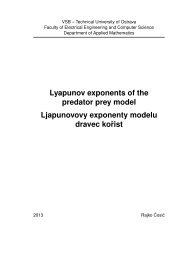The Boundary Element Method for the Helmholtz Equation ... - FEI VÅ B
The Boundary Element Method for the Helmholtz Equation ... - FEI VÅ B
The Boundary Element Method for the Helmholtz Equation ... - FEI VÅ B
You also want an ePaper? Increase the reach of your titles
YUMPU automatically turns print PDFs into web optimized ePapers that Google loves.
67with parametersp := αt x + s x1 + α 2 , q := u 2 x + (t x − αs x ) 21 + α 2 . (4.26)Notice that q ≥ 0 andq = 0 ⇔ [u x = 0 ∧ t x − αs x = 0].For α = α 1 and α = α 2 (see (4.24)) <strong>the</strong> above given situation corresponds to <strong>the</strong> point xlying on <strong>the</strong> line defined by <strong>the</strong> triangle sides x 1 x 2 and x 1 x 3 , respectively.<strong>The</strong> previous <strong>for</strong>mulae provide an analytic computation of <strong>the</strong> integral <strong>for</strong> generalparameters. However, we need to discuss <strong>the</strong> singularities that may appear in (4.25).Although <strong>the</strong> arguments of <strong>the</strong> logarithms are non-negative, <strong>the</strong>y may vanish. However,in both cases <strong>the</strong> situation is similar toln xlim x ln x = limx→0 + x→0 1 +xl ′ 1H = limxx→0 + − 1 x 2= limx→0 +−x = 0.In <strong>the</strong> case of u x = 0, i.e., <strong>the</strong> point x lying in <strong>the</strong> plane defined by <strong>the</strong> triangle τ wecan set <strong>the</strong> arctangent part equal to zero due to <strong>the</strong> jump property of V κ (3.5) and <strong>the</strong>boundedness of <strong>the</strong> arctangent function. Lastly, in <strong>the</strong> case when s = p, <strong>the</strong> last part of<strong>the</strong> function F becomes2u x arctan αqu x.4.4.4 Double Layer Potential Operator<strong>The</strong> entries in <strong>the</strong> double layer potential matrix are given byK κ,h [k, j] := 14π= 14π+ 14πτ k∂Ω τ k∂Ω τ k∂Ωϕ j (y) eiκ∥x−y∥∥x − y∥ 3 (1 − iκ∥x − y∥)⟨x − y, n(y)⟩ ds y ds x⟨x − y, n(y)⟩ϕ j (y)∥x − y∥ 3 ds y ds x⟨x − y, n(y)⟩ϕ j (y)∥x − y∥ 3e iκ∥x−y∥ (1 − iκ∥x − y∥) − 1 ds y ds x .Again, <strong>the</strong> latter integrand is bounded and we can use <strong>the</strong> 7-point scheme to compute <strong>the</strong>double surface integral. For <strong>the</strong> first integral it is sufficient to compute <strong>the</strong> local elementcontributionsD(τ, x) := 1 ⟨x − y, n(y)⟩ϕ 1 (y)4π∥x − y∥ 3 ds ywith <strong>the</strong> affine function ϕ 1 defined on τ by⎧⎪⎨ 1 <strong>for</strong> y = x 1 ,ϕ 1 (y) := 0 <strong>for</strong> y = x⎪⎩2 ,0 <strong>for</strong> y = x 3 .τ









